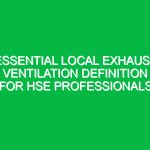Introduction
Hello team! Today, we are here for our toolbox talk to discuss an important concept that may seem counterintuitive at first: the idea that Safety Can Be Redundant. While this might sound alarming, our goal is to uncover how understanding redundancy in Safety practices can actually lead to a safer workplace. By examining the reasons behind why Safety Measures sometimes become redundant, we can improve our protocols and ensure that we are not only compliant with Regulations but are also genuinely protecting ourselves and our colleagues.
What Does ‘Safety Can Be Redundant’ Mean?
At its core, the phrase Safety Can Be Redundant refers to situations where Safety Measures may be so excessive or misapplied that they become ineffective or counterproductive. This redundancy can occur when too many overlapping Safety protocols are in place, leading to confusion rather than clarity. For example, if an employee is wearing multiple layers of Personal Protective Equipment (PPE) that overlap in function, it might not only be uncomfortable but could also result in complacency regarding the safety message.
Understanding the Importance of Effective Safety Practices
To appreciate how safety can become redundant, we first need to recognize the importance of effective safety practices. Proper safety protocols are designed to prevent accidents and injuries. However, if these protocols are poorly designed or overly complex, they can lead to a false sense of security. Employees might overlook essential safety practices because they feel overwhelmed or confused by unnecessary Procedures.
Real-Life Example: The Confusing Safety Protocol
Let’s consider a hypothetical scenario at a construction site. The crew has several safety measures in place: hard hats, reflective vests, and Safety Goggles are mandatory, and there are multiple signs reminding workers to wear their gear. However, if the site manager adds even more layers of safety without clearly communicating their purpose, workers may start to ignore the signs altogether. They might think, “Why bother?” This is a prime example of how too many safety measures can lead to redundancy and, ultimately, disregard for safety.
Identifying Redundancies in Safety Measures
Now that we understand the concept, how can we identify when safety measures are becoming redundant? Here are several key indicators:
- Overlapping Safety Protocols: When multiple procedures aim to address the same risk without clear differentiation.
- Increased Complexity: When Safety Guidelines become so complicated that employees do not understand them.
- Frequent Non-compliance: If employees habitually disregard safety measures, it may indicate that the measures are perceived as unnecessary.
- Lack of Employee Engagement: When workers do not actively participate in safety discussions or express concerns about safety protocols.
Benefits of Streamlined Safety Practices
By recognizing and addressing redundancy in safety measures, we can reap several Benefits:
- Enhanced Understanding: Streamlined procedures allow employees to grasp the importance of each safety measure.
- Improved Compliance: When safety measures are clear and concise, employees are more likely to follow them.
- Increased Engagement: Involving employees in discussions about safety can foster a culture of responsibility and accountability.
- Better Resource Allocation: Focusing on effective measures ensures that resources are used where they can have the most impact.
Best Practices for Avoiding Redundancy in Safety Measures
So, how can we ensure that our safety measures are effective and not redundant? Here are some Best Practices:
1. Regular Safety Reviews
Conduct regular reviews of safety protocols to ensure they are still relevant and effective. Involve employees in these reviews, as they can provide valuable insights based on their experiences.
2. Simplify Safety Procedures
Strive to simplify safety procedures. Ensure that each safety measure has a clear purpose and is communicated effectively. Use straightforward language and avoid jargon where possible.
3. Encourage Feedback
Create an open Environment where employees feel comfortable providing feedback on safety measures. Their first-hand experiences can highlight redundancies that management may overlook.
4. Train, Train, Train
Provide ongoing Training sessions to keep everyone informed about safety protocols. A well-informed workforce is less likely to overlook essential safety practices.
5. Utilize Visual Aids
Visual aids such as posters, diagrams, and infographics can help clarify safety protocols. Clear visuals can assist in simplifying complex procedures and making them easier to understand.
Engaging Employees in Safety Conversations
One of the most effective ways to reduce redundancy in safety practices is to engage our team in conversations about safety. Ask open-ended questions like:
- What safety measures do you find confusing or unnecessary?
- How can we improve our current safety protocols?
- Have you ever felt overwhelmed by safety procedures? How can we simplify them?
These discussions can uncover valuable insights and foster a culture of safety that encourages everyone to take ownership of their well-being.
Regulations and Standards Related to Safety Measures
Compliance with health and safety regulations is not just a legal obligation but also a commitment to creating a safe work environment. Regulations such as OSHA (Occupational Safety and Health Administration) standards provide guidelines for maintaining safety in the workplace. Understanding these regulations can help us identify unnecessary redundancies in our safety measures.
For example, if a regulation mandates certain PPE for specific tasks, overloading workers with additional unnecessary gear may not only be redundant but also counterproductive. Ensuring compliance while avoiding redundancy is crucial for maintaining both safety and efficiency.
Conclusion
As we wrap up today’s toolbox talk, it’s essential to remember that while safety measures are crucial, they can sometimes become redundant if not carefully managed. By streamlining our safety protocols, we not only enhance understanding and compliance but also foster a culture of safety that engages every employee.
Thank you for your attention and for your commitment to maintaining a safe work environment. Let’s continue to communicate openly about safety, address redundancies, and ensure that our safety practices are effective and meaningful. Together, we can create a workplace that prioritizes safety without unnecessary complications.


